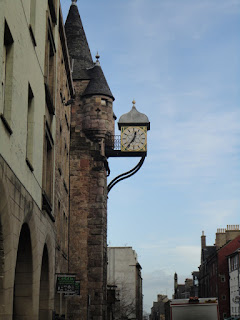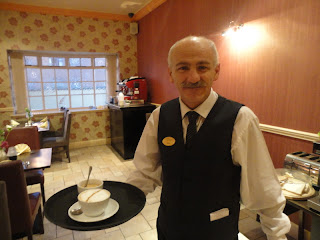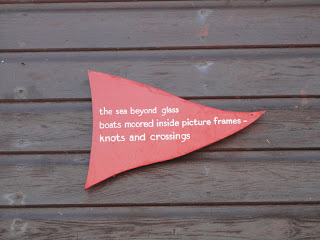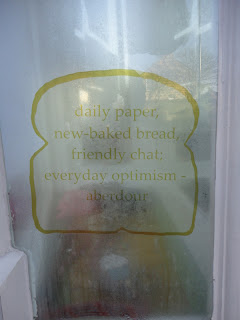Why Queensferry? you may ask. To meet the Burry Man of course. Or at least to see a model of the man preserved behind glass. Well, I actually wasn't aware of this interesting tradition until I spotted this guy in the museum in Queensferry. More about him later.
I decided to make the trip here because I was interesting in learning about the ferry that once transported people from the southern end of the firth to the northern side. Queen Margaret (future St. Margaret) who was married to Malcom III in Dunfermline, would make this journey frequently herself. She was instrumental in introducing a ferry for pilgrims making the journey from Edinburgh to St. Andrews. This is how the town got its name, and the village across the firth is called North Queensferry.
There isn't a train station in Queensferry, so I needed to alight in Dalmeny and make the walk into town to visit the museum. Of course, I did not have a map and was hard pressed to find one, so I decided that I would ask the attendant at the train station for directions to the museum.
You can imagine my surprise when I was the lone person departing the train in Dalmeny, and the station was all locked up. Not a soul to be found, not even a ticket man. I would have been out of luck had I not purchased the round trip ticket for the day.
My so-called "easy" adventure was already proving to be a bit of a challenge. I had copied some street directions down, but was completely disoriented upon arrival. I walked down the ramp, spotting a woman behind a glass door in a locked building. She was kind enough to answer the door and head me in the right direction.
She had told me that I couldn't miss High Street, and she was absolutely correct. It was a lovely little cobblestone street, lined with those quaint houses that I was looking for the other day. The funny thing is that the literature that I had read never mentioned the beauty of this little town. I was delighted to have chosen this spot to visit.
The street runs along the Firth of Forth offering an amazing view between the houses.
The town is sandwiched between the Firth Railroad Bridge and the Firth of Forth Driving Bridge, and the museum is located in the council building on this street. Luckily, the woman had told me the location of the museum. Once inside the door, I was surprised to have to ring a bell for admittance. A buzzer sounded and I was able to open the door and climb the stairs in this old building which led to a door that had a Museum sign above it. I was curtly informed by a man in the room that there were only 2 rooms open for viewing, and that the 3rd room was closed as it was being refurbished.
Wouldn't it figure that the closed room housed the telescope for viewing the firth? There wasn't much that I could do about that, and since this museum was free, I really couldn't complain, could I?
So, I began to read through the history of the town and the building of the railroad bridge over the firth, which actually began in 1883, was finished in 1890 and continues to be used today. Pretty amazing, don't you think?
In my thirst for my information regarding this town, I began to ask the man behind the desks some questions. I was curtly told that he was not familiar with the museum's contents and that he was filling in for someone. Well, so much for that!
The museum is small, but has some very interesting displays regarding the town and its previous industry. One item of particular interest was an explanation of the mining of shale that was done from 1862 to 1962, the purpose of which was to extract oil. The display went on to explain the active oil industry in this town and the hazards surrounding the work. I think my mouth was hanging open at this point.
My first job with Gulf Research as a Chemical Engineering, involved this very premise. Here I was, attempting to design an efficient process that could be used on a large scale, and the Scots had successfully proven that this could be done for 100 years!
On my way out of the museum, after descending the stairs, I spotted an empty conference room that offered a spectacular view so I sneaked in and took a couple of photos through the window. So much for Mr. Crabby upstairs!
One of the items of interest in the museum was the mention of the Hawes Inn and its connection to Robert Louis Stevenson's novel, "Kidnapped." He had apparently stayed at the inn when the idea of the book came to him. I was so close, and the train wasn't scheduled for quite awhile, so how could I resist the opportunity of seeing this place first hand?
This time, it was a straight stretch, on a paved sidewalk that ran along the firth.
The Hawes house continues its role as a hotel, just as it had been back in Stevenson's day. It stands in the shadow of the Forth Railroad bridge, and is directly across the street from the ferry that would take people across the firth so many years ago.

As I headed back towards town, I couldn't help but admire the beauty of High Street.
I'm fairly certain that a short cut exists from High Street up the hill to the Train station, but I had decided that I was not going to wary from the path. By this time, the weather turned for the worse, and I found myself walking along the street, getting soaked from the rain that was falling.
I passed the old Tollbooth built in 1636
and Black Castle built in 1626.
But that, I hear, is typical Scottish weather. I was just happy that I managed to get back without incident and didn't get lost! But, in my opinion, the town of Queensbury has a lot of history worth sharing, and someone should think about putting together a walking map highlighting some of these historical and fabulous looking buildings.
But wait! You want to read the Burry Man story, right? This is a pagan tradition whose origins are unknown.
Every year, on the second Friday of August, a man in the town collects burrs himself, and begins to cover himself entirely with them. Once he is fully covered in his costume he leaves the center of town around 9:00 a.m. and parades around, stopping in each of the pubs where he is offered a drink of whiskey through a straw. He has a couple of attendants with him should he need assistance. (I wonder if they get free drinks as well?)
The story never goes on to tell just why this event occurs. And who came up with the free whiskey through a straw idea? I'm thinking that he needs the hard stuff in order to deburr at the end of the day!
What do you think?


























































